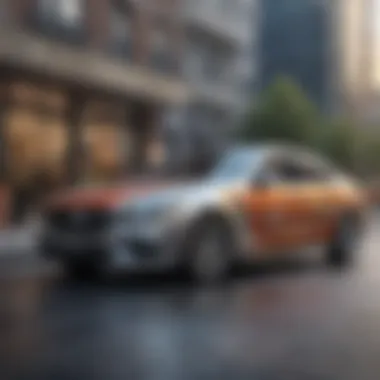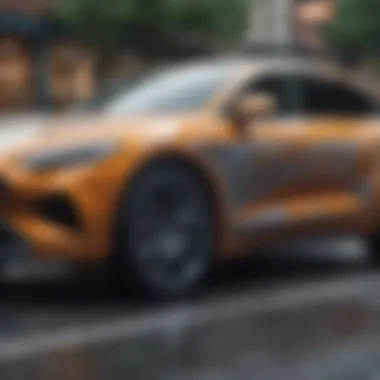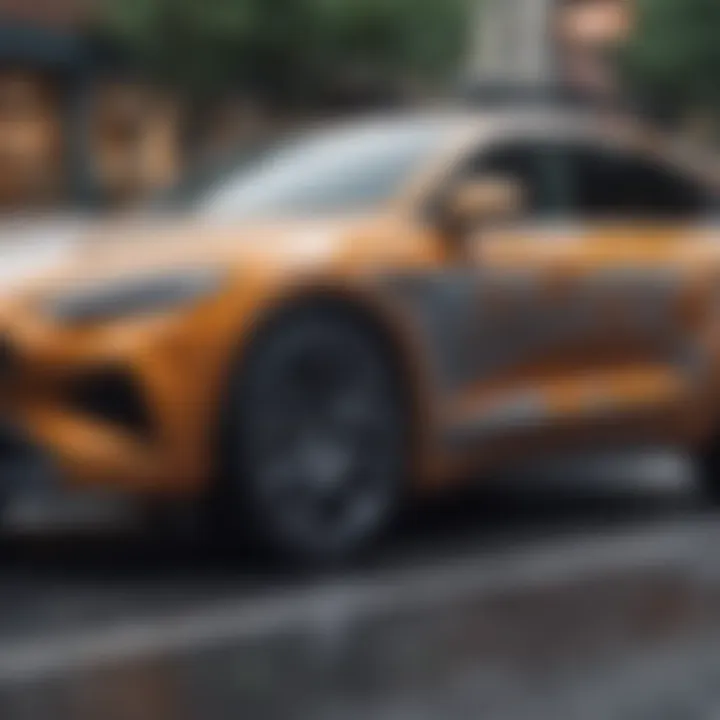Understanding Vehicle Wrap Advertising Costs


Intro
In a crowded marketplace, businesses constantly seek innovative methods to stand out, and vehicle wrap advertising emerges as a unique way to do just that. This advertising approach involves wrapping a vehicle with a large vinyl graphic that showcases branding and promotional content. While it may seem simple on the surface, countless layers to vehicle wrap advertising lie beneath its glossy exterior. Understanding the costs associated with this method is paramount for enterprises looking to achieve a robust return on investment in today’s competitive climate.
Today, we dissect the multifaceted nature of vehicle wrap advertising, looking closely at factors that influence its costs, the potential financial benefits, as well as installation and maintenance aspects. This exploration isn’t just about slapping a colorful wrap on a company car; it delves deeper into strategy, nuances of budgeting, and the overall effectiveness of this advertising modality against other available options. We aim to provide a well-rounded perspective that assists businesses in evaluating whether vehicle wraps suit their advertising strategy.
Let’s start by defining essential investment concepts that will underpin our analysis.
Overview of Vehicle Wrap Advertising
In the world of marketing, vehicle wrap advertising stands out as a dynamic method that transforms automobiles into moving billboards. This form of advertising captures attention and creates brand visibility on the road, leading potential customers to engage with the brand in a tangible way. Importantly, businesses must grasp the intricacies involved in vehicle wrap advertising, particularly the costs associated with it. Understanding these costs ensures that companies using this method can not only make informed investment decisions but also see genuine returns.
Definition and Purpose
Vehicle wrap advertising refers to the process of covering a vehicle with vinyl graphics that display a business's branding, logo, or promotional content. The purpose is straightforward yet powerful: to increase visibility in various environments, from city streets to parking lots. When designed effectively, a vehicle wrap can turn a simple car or truck into an eye-catching mobile advertisement.
The appeal lies in its capacity to reach a broad audience daily, making it an attractive option for both small businesses and large corporations. Given its ability to engage people in everyday situations, vehicle wrap advertising can establish strong recognition of a brand, sparking interest and potentially driving sales.
Historical Context
Looking back, the roots of vehicle wrap advertising can be traced to the rise of automobile culture in the early 20th century. As cars became more commonplace, so too did their potential as advertising mediums. In the 1990s, the advancement of vinyl technology allowed for more complex designs and easier application. Screen printing was previously a favored method, but it required more time and financial investment, leaving smaller businesses at a disadvantage.
Now, with digital printing capabilities, companies can create vivid and intricate designs quickly and affordably, enabling even startups to take advantage of vehicle advertising. As urbanization continued to grow, so did the need for effective marketing methods. Vehicle wraps emerged as a savvy alternative to traditional advertising methods—rooted in the desire to maximize visibility while minimizing costs. Today, vehicle wrap advertising is an important element of many marketing strategies, providing a unique way for businesses to communicate their message and enhance brand recall.
"The streets are now filled with opportunities for brands to be noticed; vehicle wraps are capitalizing on that every day."
In summary, understanding vehicle wrap advertising involves recognizing its definition, purpose, and historical development. These elements remind us that this approach is not just a current trend—it is a marketing method that has evolved to meet the changing landscape of consumer behavior and advertising needs.
The Cost Structure of Vehicle Wrap Advertising
Understanding the cost structure of vehicle wrap advertising is crucial for businesses contemplating this method as a marketing strategy. When considering an investment in vehicle wraps, firms need to have a clear grasp of each component that contributes to the overall cost. This includes materials, design, installation, maintenance, and removal, each carrying its implications for budgeting and return on investment.
Breaking down these costs allows marketers and business owners to not only anticipate their initial investment but also project long-term financial viability. Grasping the financial aspects also positions businesses to make informed decisions that could influence operational logistics and advertising effectiveness.
"Knowing where every penny is allocated turns potential losses into calculated risks."
Material Costs
Material costs form the backbone of any vehicle wrap project. These expenses revolve around the vinyl film and various adhesives used to create the wraps. The type of vinyl selected can significantly impact the overall wellbeing of the wrap, as different grades offer varied guarantees regarding durabilty and appearance.
For instance, high-quality materials might come at a premium, yet they often reflect in the longevity and visual appeal of the advertising. Common types of film include cast vinyl, which is favored for its flexibility; calendared vinyl, which is typically less expensive; and specialty films designed for unique applications or effects. Coupled with the cost of inks and finishes, selecting the right material requires balancing quality with budget.
Design Costs
The heart of any successful vehicle wrap is its design. This cost element encompasses creative services, which can vary widely depending on the complexity of the design and the reputation of the designer. Engaging an experienced designer can be a wise investment, as they know how to balance aesthetics with communicative efficacy.
For businesses aiming for impact, the design must not only grab attention but also accurately reflect the brand's ethos and message. Additionally, the design should consider the vehicle’s specific contours, ensuring every curve enhances the visibility of the messages.
Installation Costs
Installation costs represent an often-overlooked aspect of vehicle wrap expenditure. The craftsmanship involved in applying the wrap is vital because poor installation can lead to premature wear and tear. Professional installers have the expertise and tools to ensure that the wrap is applied seamlessly, minimizing the likelihood of air bubbles, misalignment, and other common issues.
It's wise for businesses to seek quotes from multiple professional installers. Investing in expert services can pay off in the long run, as it not only enhances appearance but also contributes to durability.
Maintenance Costs
Once a vehicle is wrapped, ongoing maintenance costs come into play. This can involve regular cleaning, inspections for wear, and prompt repairs for any damage incurred during use. Regular care can significantly extend the life of the wrap and ensure that the vibrant graphics continue to capture attention.
Many wrap companies suggest specific cleaning agents and techniques to maintain the integrity of the graphics while protecting the surface beneath. Neglecting maintenance could lead to unsightly damage and potentially force a business to replace the wrap sooner than expected.
Removal Costs
The final piece of the cost structure is often ignored until necessary: removal costs. When it’s time to change or update a wrap, the removal process must be handled carefully to avoid damage to the vehicle itself. Professional removal can prevent issues such as adhesive residue, which could reduce the vehicle’s resale value.
Understanding these removal costs upfront helps businesses budget for ongoing marketing. The smoother the transition, the less likely it is that a vehicle will be out of commission or left uninformed between wraps.
Factors Influencing Vehicle Wrap Advertising Costs
Understanding the costs associated with vehicle wrap advertising requires a keen eye on several influencing factors. These elements play crucial roles in determining the overall expenditure of implementing a vehicle advertising campaign. Each of these factors does not just affect the immediate financial outlay; they also have long-term implications on the return on investment, brand visibility, and campaign effectiveness. Evaluating these components allows businesses to achieve a clearer picture and make astute financial decisions.


Size of the Vehicle
The dimensions of the vehicle are paramount when calculating the cost of wraps. Naturally, larger vehicles like trucks or buses necessitate more material and additive labor compared to compact cars. For instance, wrapping a standard van can vary significantly from a full-size SUV in terms of both time and material consumption.
- Material Usage: Here, more surface area means a greater quantity of vinyl required, inherently raising the material cost.
- Labor Time: Additionally, larger vehicles typically demand more careful installation, which can stretch labor costs further.
- Design Considerations: A bigger canvas also allows for more intricate designs or broader messaging, which may necessitate professional design services.
Thus, businesses need to weigh their options carefully based on the vehicle type they plan to use, as this can lead to substantial changes in the overall cost of the wrap.
Type of Material Used
Another significant aspect is the type of vinyl material selected for the wrap. There are various options available, ranging from basic calendared vinyl to premium cast vinyl.
- Durability: Premium materials are generally more durable and weather-resistant but come with a heftier price tag.
- Aesthetic Quality: High-quality materials allow for better color depth and longevity, which can impact not only the initial investment but the visibility and impact of the branding over time.
- Specialty Films: Options like reflective or textured films might drive up costs even further and should be contemplated based on branding goals and targeted demographics.
Selecting the right material involves understanding the balance between cost and the desired impact on potential customers.
Complexity of the Design
The more elaborate the design, the more complex the costs. A simple logo on a solid background is going to be cheaper than a design filled with graphics, images, and text.
- Graphic Design Fees: Engaging a professional designer can add to the total expense. The intricacy of the design often dictates how long designers take for adjustments as clients’ thoughts evolve.
- Printing Costs: Detailed designs often require multiple print runs, which can lead to increased expenditure.
- Installation Challenges: Additional design elements can also complicate the wrap installation process, requiring more experienced hands or longer installation times.
Thus, businesses need to assess the aesthetic goals carefully and align them with their budgetary constraints to avoid going down the rabbit hole of design complexity.
Geographical Location
Lastly, the geographical context can heavily influence the costs associated with vehicle wraps. The cost of labor and materials can vary tremendously based on location. Major metropolitan areas tend to have higher costs due to increased demand and living expenses among service providers.
- Labor Costs: Regions with higher costs of living naturally experience increased labor costs, which can contribute to the overall price tag for installation.
- Competition and Market Variability: The local market for vehicle wraps can also affect pricing. In areas where competition is fierce, prices may be driven down, while in areas with few providers, businesses might find themselves paying a premium.
- Regulatory Factors: Certain regions may have specific regulations regarding vehicle advertising, which could impose additional costs for compliance and adjustments.
In summary, factors including vehicle size, material selection, design complexity, and geographical location all intricately weave into the cost framework for vehicle wrap advertising. Being aware of these influences can greatly aid organizations in making educated choices, ultimately leading to more successful advertising initiatives.
Comparative Analysis with Other Advertising Methods
When exploring the landscape of advertising, it's imperative to understand where vehicle wrap advertising fits among other options. Each method has its unique characteristics, and the comparison can reveal strengths, weaknesses, and contexts in which one may be more beneficial than another.
This section will delve into traditional billboards, digital advertising, and social media marketing. By examining these alternatives, businesses can make informed decisions about where to allocate their advertising budgets effectively.
Traditional Billboards
Traditional billboards have long been a staple in advertising. They offer high visibility due to their large size and placement in strategic locations. Yet, the costs associated with billboards can quickly stack up.
- Installation and Leasing Costs: Securing a billboard often requires leasing, which can vary widely depending on the location. You might pay hundreds or even thousands of dollars per month.
- Limited Engagement: Billboards relay a message quickly, but do not allow for any interaction or engagement from the audience. Once you’ve got it up, that’s it; there are no tweaks you can make down the line.
- Lifecycle: Advertisements remain for a predetermined duration. Changing the design or message means additional costs.
While billboards can reach a broad audience, the static nature limits their effectiveness compared to more dynamic methods.
Digital Advertising
Digital advertising has revolutionized how businesses can target their audiences. If there’s anything that sets it apart, it’s the ability to track and analyze engagement in real time. Yet, it has its drawbacks as well:
- Cost Variability: The costs can fluctuate drastically based on audience targeting and competition. Ads can be deceptively affordable at first but can escalate if not monitored well.
- Ad Fatigue: Users often see the same ads repeatedly, leading to a phenomenon known as 'ad fatigue,' where engagement dwindles.
- Complexity in Setup: Setting up effective ads requires know-how and sometimes hiring specialists, which adds to the initial outlay.
In contrast to static billboards, digital ads can be adjusted on the fly, allowing businesses to refine their approach based on performance.
Social Media Marketing
Social media marketing is yet another avenue worth exploring. It allows brands to connect with potential customers on platforms where they spend a significant amount of their time. Here are some key points:
- Interactive Nature: Unlike billboards, social media allows for direct interaction with consumers, be it through comments, likes, or shares.
- Targeted Advertising: Precision targeting enables businesses to advertise to specific demographics increasing the likelihood of conversion.
- Cost Efficiency: Many platforms offer tiered pricing based on reach and engagement, which can lead to more cost-effective campaigns.
However, businesses should be wary of the constant need for fresh content to maintain engagement. Without regular updates or engagement, even the most promising campaigns can dwindle.
Effective comparison of advertising methods helps businesses identify the strengths and weaknesses of each, optimizing investment and maximizing reach and engagement.
In summary, while vehicle wrap advertising has distinct advantages, the competitive landscape includes methods like traditional billboards, digital ads, and social media. Understanding these options can guide marketers in making astute choices that align with their objectives and budget constraints.
Benefits of Vehicle Wrap Advertising
In the world of marketing, where trends come and go faster than a New York minute, vehicle wrap advertising stands out as a compelling option for businesses eager to make their mark. This strategy not only transforms ordinary vehicles into eye-catching advertisements, but it also delivers several crucial benefits that are worth considering. Here, we will delve into several key advantages of vehicle wraps, emphasizing how they can change the game for advertisers.


Enhanced Brand Visibility
When it comes to brand visibility, vehicle wraps act as giant moving billboards. An attractive wrap can grab attention from passerby, helping a business to reach a broader audience every day without needing a specific location. Imagine a bright, colorful design that draws the eye, standing out against the monotonous backdrop of city streets. Each time a wrapped vehicle is on the road, it’s potentially seen by thousands, making this an effective way to turn heads.
Additionally, the sheer size of a vehicle allows for more creative freedom compared to smaller ads. In this case, larger-than-life graphics or unique shapes can create a memorable brand experience. Over time, this consistent exposure can lead to brand recognition — the more often someone sees a brand, the more likely they are to remember it during purchasing decisions. Hence, vehicle wraps help in creating a visual identity that sticks.
"A vehicle in motion is a brand on the move. Creating visibility is key to persuading the audience."
Cost-effectiveness Over Time
In the long run, vehicle wraps can save businesses more money than traditional advertising methods. Sure, there’s an upfront cost associated with design, materials, and installation. However, once the wrap is up and running, it doesn’t require constant spending like billboards or online ads.
Think about it: a wrap can last anywhere from three to eight years, depending on factors like material quality and maintenance. In contrast, running online ads or billboard placements often requires ongoing budgets that quickly add up. Not to mention, the wrap functions 24/7, maximizing exposure without further costs. This means that companies could see significant returns on investment, especially when considering how many impressions a wrapped vehicle makes compared to passive digital ads.
Targeted Marketing Potential
Another compelling advantage of vehicle wraps is their ability to target specific demographics. A business can develop a wrap that engages a particular market, based on a vehicle’s location or the routes it typically takes. For example, a delivery truck for fresh produce may operate mainly in residential neighborhoods, where families are keen on organic food. By customizing the design to appeal to those consumers with bright, farm-fresh imagery, the wrap effectively speaks to its intended audience.
Moreover, vehicle wraps can be strategically deployed in high-traffic areas or events relevant to the target audience, enhancing their efficacy. This personalized approach can drive interest and inquiries, making the advertising feel less intrusive and more organic.
In essence, vehicle wrap advertising is not merely a decoration; it’s a rich blend of visibility, cost-effectiveness, and targeted outreach, providing businesses a substantial edge in a crowded market.
Calculating Return on Investment
Understanding how to calculate return on investment (ROI) is paramount for businesses considering vehicle wrap advertising. ROI serves as a crucial metric that allows companies to assess the effectiveness and profitability of their marketing strategies. When engaging in vehicle wrap advertising, it’s not just about the upfront costs; it’s also about what those costs yield in terms of visibility, customer engagement, and ultimately sales.
From the get-go, it’s clear that vehicle wraps are not merely an expense; they are an investment. Gauging the return from this investment requires pulling together various pieces of data to paint a full picture. This becomes especially important for investors and entrepreneurs who want to ensure their money is well spent. Let’s break down some key elements and considerations in the calculation of ROI for vehicle wrap advertising.
Establishing Key Performance Indicators
To accurately measure ROI, businesses must first establish key performance indicators (KPIs) that align with their advertising goals. KPIs help in tracking the effectiveness of the vehicle wraps in real time. Here are some useful KPIs that can be focused on:
- Increase in Customer Inquiries: Monitoring the number of inquiries received can directly indicate the level of interest generated by your wraps.
- Website Traffic: An uptick in visits to your website will often correlate with the visibility your wrapped vehicle provides.
- Social Media Engagement: Tracking likes, shares, and comments can illustrate how well your wrap resonates with the audience.
- Conversions: Ultimately, analyzing conversions will tell you how many inquiries or interactions led to actual sales.
Each of these KPIs should be carefully analyzed and adjusted according to the nature of the business and its unique marketing goals.
Tracking Sales and Engagement Metrics
Once KPIs are in place, the next step is to track data effectively to make informed decisions moving forward. This involves analyzing both sales figures and engagement metrics that may arise post-campaign launch. Here are some strategies for tracking:
- Utilizing Tracking Software: Employing tools like Google Analytics or CRM systems can help in collecting and analyzing data on inquiries and sales conversions in relation to the timeline of the advertising.
- Surveys and Feedback: Sending surveys to customers can provide insights into how they learned about the business, offering direct feedback on the awareness generated by vehicle wraps.
- Promotional Codes: Using specific codes that are only advertised on the vehicle wraps can help draw a direct line between the advertising and the sales generated from those efforts.
By correlating these metrics with the costs involved in vehicle wrap advertising, businesses can better understand their ROI, ensuring that they remain both informed and strategic in their marketing decisions.
Calculating return on investment isn't just a number on a spreadsheet; it’s a powerful tool that can inform better marketing strategy and spending decisions. Businesses can evaluate where to allocate resources effectively, ensuring maximum impact for their advertising expenditures.
Case Studies and Success Stories
Examining case studies and success stories provides tangible insights into the effectiveness of vehicle wrap advertising. These real-world examples serve as touchstones for businesses contemplating whether such investment aligns with their marketing strategies. When decision-makers look at others who’ve navigated the treacherous waters of marketing, they tend to feel more secure about making similar choices. Success stories can bolster confidence, highlight viable strategies, and illustrate potential pitfalls.
Small Businesses
For small businesses, the prospect of vehicle wrap advertising can be particularly appealing. Consider a local artisan bakery based in a bustling town. After investing in a vibrant vehicle wrap that prominently displays their logo and signature treats, they noticed a marked increase in foot traffic. The eye-catching design, which cleverly incorporated a whimsical illustration of their signature cupcakes, attracted the attention of passing cars and pedestrians alike. As people began to associate their mobile advertisement with the delicious offerings of the bakery, sales increased by nearly 25% within just a few months.
Such examples are not isolated. Small businesses often find that the cost-effectiveness of vehicle wraps can outweigh traditional advertising methods. They can turn everyday travel into a marketing opportunity without a heavy ongoing investment. By driving their wrapped vehicles around local events and high-traffic areas, they’re continuously promoting their brand.
Large Corporations
On the other side of the spectrum, large corporations can leverage vehicle wrap advertising on a much grander scale. Take a national plumbing company that rolled out an extensive fleet of wrapped service vehicles. The design, cohesive with their other marketing materials, was not only visually appealing but also reinforced their commitment to service quality.
After implementing this strategy, they reported a 40% increase in service calls over a six-month period. With multiple vehicles traversing their service area, the advertisement reached countless potential customers daily. The return on investment was significant, making their initial outlay feel like small potatoes in the grand scheme of things.
Large corporations often have the advantage of running coordinated campaigns that integrate digital marketing efforts with vehicle wraps. By encouraging customers to engage on social media while spotting their vehicles, they not only expanded their reach but created a community around their brand, further driving customer loyalty.
"Case studies play a vital role in understanding the practical benefits and challenges of vehicle wrap advertising."
By dissecting these examples from small businesses and large corporations, potential investors and financial advisors can better assess the merits and challenges of vehicle wrap advertising. They illuminate how, regardless of the scale, effective use of vehicle wraps can amplify a brand's message, making it resonate more with the target audience.
Common Pitfalls in Vehicle Wrap Advertising


Vehicle wrap advertising can offer quite a bit of bang for your buck, but it doesn’t come without its challenges. It’s important to navigate the waters carefully lest you end up sailing into a storm. The underlying theme here is awareness: Knowing specific pitfalls aids in making more educated decisions that safeguard your investment.
Underestimating Total Costs
Expecting to slap on a wrap and be done with it is a bit naive. Many businesses fall into the trap of thinking that the sticker price is all there is. In reality, there are numerous expenses that can quickly stack up, leaving your budget in tatters. While you might budget for the initial expense of the wrap itself, consider hidden costs that can surface.
"Ignoring the full picture can lead to an expensive lesson."
Additional costs can include:
- Design fees: Often ignored until the last minute. You may need to hire a designer to create a compelling and eye-catching wrap.
- Installation fees: A cheap wrap isn’t much use if it’s poorly installed. Hiring professionals to ensure the wrap is applied correctly mainly adds to your overall cost.
- Maintenance costs: Failing to include the upkeep of the wrap in your budget can be a slippery slope.
- Removal fees: Eventually, the wrap will need to come off, and having a plan for this can ease future financial burdens.
Ultimately, it would be wise to create in-depth budgeting that extends beyond aesthetics to include each element involved in vehicle wrap advertising.
Neglecting Maintenance
Once the wrap is on, it’s easy to forget about it until you notice it's fading or peeling. Treating it like a one-time investment without ongoing care can spell disaster. Neglect here isn’t just about looks; it impacts visibility and effectiveness. Dirt, grime, and natural elements can cause deterioration over time.
Regular maintenance includes:
- Cleaning: A simple wash can do wonders. It protects against harmful substances adhering to the wrap.
- Inspections: Regular checks for damage cuts down further issues down the line. If you find a small tear, addressing it immediately can prevent more significant costs later.
A little bit of diligence can prolong the life of your wrap, ensuring you see returns on that original investment.
Ignoring Local Regulations
It may sound simplistic, but local laws can throw a mega wrench into your plans if not followed properly. Each place comes with its own set of regulations regarding mobile advertising, often concerning size, branding clarity, or even content itself. Ignoring these can lead not only to fines but also potential removal of the wrap, nullifying all the effort and cost.
Here are a few tips:
- Research local ordinances: Ignorance of the law can be costly.
- Consult with experts: Professionals or local advertising associations can be invaluable for understanding regional rules.
- Keep documentation handy: Even having written approvals can be helpful just in case you need to prove compliance later.
By being proactive in these areas, businesses can save themselves from unplanned headaches and costly fines, ensuring that vehicle wrap advertising remains an effective marketing strategy without unwanted surprises.
Future Trends in Vehicle Wrap Advertising
The landscape of vehicle wrap advertising is rapidly evolving, driven by technological advancements and changes in consumer behavior. Understanding these future trends is crucial for businesses aiming to remain competitive in a world where traditional marketing methods are being continuously challenged. This section delves into the remarkable innovations on the horizon and how shifting consumer preferences could reshape advertising strategies.
Technological Innovations
Emerging technologies are fundamentally altering the game in vehicle wrap advertising. The advent of digital printing techniques has led to unprecedented design flexibility and accuracy. Companies can now produce wraps that boast vibrant colors and intricate details that were previously nearly impossible to achieve. For instance, the use of latex inks not only provides a visually stunning finish but also promotes a more ecological approach to production, appealing to environmentally conscious consumers.
Also noteworthy are advancements in material technology. Manufacturers are now creating wraps that offer enhanced durability and adhesion while being easier to remove. These high-performance vinyl materials have longer life spans, which means businesses can keep their wraps for extended periods without sacrificing quality.
Integrated QR codes embedded within some wraps allow potential customers to access more information about the brand instantly. This not only boosts engagement but also provides critical data that companies can analyze for targeted marketing strategies.
Moreover, the rise of augmented reality provides exciting possibilities. Imagine a customer pointing their mobile device at a vehicle wrap and being instantly transported into a more interactive experience about the product or service being advertised. This type of innovation can enhance brand storytelling, creating a memorable interaction far more engaging than traditional advertising could offer.
Shifts in Consumer Behavior
The preferences of consumers are also shifting significantly, akin to a ship changing its course. People are becoming increasingly selective and discerning with their engagement, often choosing brands that not only understand their needs but also resonate with their values. This shift has implications for vehicle wrap advertising, driving businesses to rethink their messaging and how it's presented.
There is an increasing demand for authenticity in marketing. Consumers are not just interested in flashy designs but want to connect with brands on a personal level. Transparent messaging that aligns with ethical practices will draw consumers in more than a mere aesthetic can. As a result, companies using vehicle wraps must focus on telling genuine stories through their designs. This means integrating cultural relevance or community-focused messages
Another critical shift is the growing inclination towards localism. With more consumers interested in supporting local businesses, vehicle wraps that emphasize community ties or local heritage can resonate more with target audiences. This can take the form of using local artists for designs or incorporating local landmarks, which instills a sense of pride and connection in potential customers.
"The future of vehicle wrap advertising is not only about getting visibility but truly engaging with an audience that seeks meaningful interactions with brands."
Adapting to these trends will not just enhance the effectiveness of vehicle wrap advertising but also ensure that businesses remain relevant in an ever-evolving landscape. It's an exciting time for companies willing to innovate and understand what consumers value. As businesses harness these technological advances and shifts in consumer sentiment, the potential for impactful vehicle wrap advertising becomes limitless.
Culmination
In diving into the topic of vehicle wrap advertising, it’s clear that this method of marketing holds a significant place in the advertising landscape. The multifaceted costs associated with vehicle wraps serve as the backbone to understanding their financial viability for businesses. By analyzing various expenses such as material, design, installation, maintenance, and removal, businesses can weigh their options more effectively.
Moreover, understanding these costs allows companies to set realistic budgets while planning their advertising strategies. It's not just about the initial expenditure but also considering the long-term benefits, especially when it comes to return on investment. When executed correctly, vehicle wrap advertising can yield higher visibility and customer engagement while providing a distinct edge over traditional advertising methods.
Another critical element discussed throughout this article is the common pitfalls that businesses face. Being aware of these potential stumbling blocks, from underestimating total costs to overlooking local regulations, is essential for any investor or entrepreneur looking to make their mark in the advertising realm.
Thus, the importance of vehicle wrap advertising lies not only in its direct costs but in the broader narrative of its effectiveness and the strategies behind it. It’s about making informed decisions, leveraging transparency in the cost structure, and ultimately crafting campaigns that align with business goals.
"Investing in vehicle wrap advertising is not merely a financial decision; it's an investment in brand evolution and market presence."
Final Thoughts
Reflecting on the insights drawn from this article, businesses need to approach vehicle wrap advertising with a keen awareness of their specific needs and market demands. Each vehicle wrap project has its own unique story depending on vehicle size, design complexity, and location.
For those considering this marketing avenue, engaging with professionals who understand both the creative and logistical aspects of vehicle wraps is essential. Not only can they guide companies through the process but they can also provide insights based on real-world experience.



